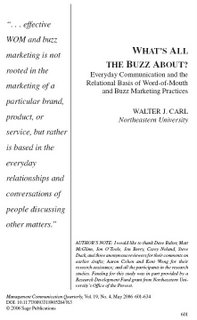 Well, it's finally here!
Well, it's finally here!
My manuscript entitled "What's All the Buzz About?: Everyday Communication and the Relational Basis of Word-of-Mouth and Buzz Marketing Practices" has been published in Management Communication Quarterly.
Due to copyright restrictions I am not able to post the official version online. However you can order a reprint from the publisher's website or you can download the unofficial, pre-press version at my download page (which has been available for some time and includes color graphs and additional tables that we couldn't fit in the official version due to page constraints).
Here's the abstract:
Although the influential role of word-of-mouth communication has been known for decades, a more recent phenomenon is the emergence of explicit organizational efforts to stimulate “buzz” (contagious talk about a brand, service, product, or idea). Buzz marketing organizations either pay people, or seek volunteers, to try new brands and then have agents “talk them up” among their social networks. This article contends that the practice of buzz marketing is usefully framed within the study of everyday communication, which has shown considerable growth in the field of communication studies over the past decade. This framework provides a reliable scientific source and basis on which to base further claims about the effectiveness and ethics of buzz marketing.In case you're interested here's a chronology of significant events regarding the study, press mentions, and its journal publication:
Mid-December 2004: Initial idea for project conceived: to test theories of everyday conversations and relational communication in the context of organized word-of-mouth marketing programs and to compare word-of-mouth communication activities of "everyday people" (those not participating in an organized WOMM program) with WOMM agents/program participants.In summary, from initial idea to official publication: 15 months.
Late December 2004: Made phone contact with word-of-mouth marketing company to discuss their interest in collaboration and feasibility of project.
January 2005: Initial meeting with WOMM company to explain research goals. Additional meetings follow.
January 2005: Division of Research Integrity approval process (required for all academic research projects in order to protect the rights of research participants and to treat the data generated appropriately).
February 2005: Agent data collection... recording the number of interactions for a one-week period and the percentage of those interactions that include brand-related talk. Also to learn more detailed information about specific campaign-related and non-campaign related WOM episodes.
February & March 2005: Recruitment for "everyday people" portion of study and data collection. This also involved recording the number of interactions for a one-week period and the percentage of those interactions that include brand-related talk. Also they completed a detailed survey for their "everyday" (organic) WOM episodes.
March 2005: Coding of open-ended responses and data analysis.
April 2005: Writing up results for publication. Submission to journal.
May 2005: Journal begins blind, peer-review process. Manuscript sent to three peer reviewers (in this context blind review means that the reviewers do not know who the author is).
June 2005: Interview with Wall Street Journal reporter William M. Bulkeley. Research finding from study cited in his article "Marketers Scan Blogs for Brand Insights"; Thursday, June 23, 2005. B1.
Mid-July 2005: Presentation of initial results at WOMMA's Measuring Word-of-Mouth conference (PDF file for presentation). Podcast interview with Ben McConnell where I discuss the study's results at WOMMA Metrics conference.
Late-July 2005: Receive notification that manuscript has been accepted for publication on first submission with only minor revisions needed. I learn it will appear in Volume 19, which means it will likely appear in 2006, but not sure which issue number.
Late-July 2005: Minor revisions submitted to journal.
August 2005: Figures (graphs, tables, etc.) submitted. WOMM company releases industry white paper based on results of study. WOMMA includes link to white paper in their WOMNIBUS newsletter. Church of the Customer writes about the industry white paper and the academic study upon which that white paper is based.
September 2005: I learn that no further revisions are required to the manuscript. Post a pre-press version to my download page.
November 2005: I learn that manuscript will appear in Issue 4 of Volume 19.
November 2005: Contacted by journal to determine excerpt that will appear on title page. I suggest the following from the last sentence of the manuscript: "... effective WOM and buzz marketing is not rooted in the marketing of a particular brand, product, or service, but rather is based in the everyday relationships and conversations of people discussing other matters."
February 2006: Jack Morton cites study in their piece on experiential marketing.
March 2006: Received content alert via e-mail that Volume 19, Issue 4 is now available for electronic access online.
From initial submission to official publication slightly less than 12 months.
In the world of blind, peer-reviewed academic journal publication this is fairly quick. As a point of comparison I have another manuscript written with a colleague where the data was collected in 2003, submitted to a journal and accepted for publication in 2004, and we are still waiting for it appear in print (going on 3 years now!!!).
Recommend citation for article (APA-style):
Carl, W. J. (2006). What's all the buzz about? Everyday communication and the relational basis of word-of-mouth and buzz marketing practices. Management Communication Quarterly, 19(4), 601-634.
Tags --> word of mouth wom buzz marketing academic publication journal publication process





|